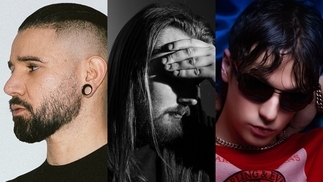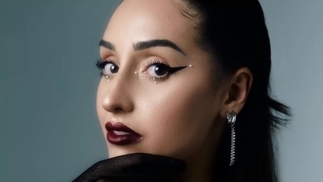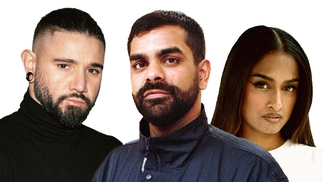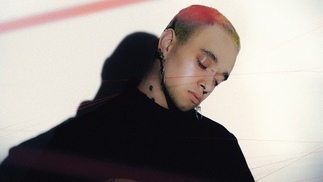Jump up and get down: DJ Mag investigates the UK's jump-up D&B revival
The high-energy drum & bass sub-genre is back... and in a very big way!

Jump-up — the bouncy, bassline-led strain of drum & bass — seems bigger than ever right now. DJ Mag talks to the leading playaz in the sub-genre — Hype, Hazard, Heist, Serum, Upgrade, Macky Gee and lots more — to investigate the reasons for its return to prominence and hear how even some EDM DJs and Skrillex are jumping on board...
WORDS: Dave Jenkins
Andy C is rinsing Original Sin classics. Hype is hosting Playaz’ first ever festival arena in its 21-year history at SW4. Festivals such as Let It Roll and Hospitality In The Park are stacked with names such as Guv, Annix, Levela, Turno and Macky Gee. Skrillex is playing Upgrade tunes. Jauz is playing Hazard tunes. Everyone is playing Turno’s ‘Invaders’. Scene innovators Clipz and Generation Dub are coming back, and it’s now officially against the law to not sing along to the basslines on ‘Mr Happy’ and ‘Bricks Don’t Roll’...
If there’s been one particularly dominant dynamic in drum & bass in the last year, it’s the big, hooky, bassline-led sound that’s often referred to as jump-up. But please don’t call this a comeback. Whether you’d paid attention to it or not, jump-up has been one of the most consistent, die-hard sub-genres of drum & bass since jungle splintered from hardcore in 1992.

Andy C
DANCEFLOOR
“Jump-up started back in the early ‘90s largely due to producers like Roni Size, Krust, Die and all those guys,” explain the Serial Killaz, long-standing jump-up supporters and ragga fusionists. “The basslines started to get more riffy, more energetic, and that seemed to herald a new dawn of drum & bass. Then of course you had labels like Urban Takeover, Trouble On Vinyl, Undiluted, Formation and the True Playaz camp all making big waves until the late ‘90s where it seemed to die down for a while. Then around 2004 producers like Distorted Minds, Generation Dub, Twisted Individual, Clipz and Hazard all started what we think was the beginning of this new jump-up sound that we have now.”
Potted jump-up histories don’t get more succinct. Yet more recently it’s a sound that’s become too broad to universally define. One person’s jump-up is another’s dancefloor drum & bass... And another person’s noise. From the particularly virulent strain of angular, atonal gurning grit that’s come from Belgian artists such as Spaow and Trafalgar to the rolling jungle grooves of Serum, Voltage and T>I — almost any riff-heavy, underground style of drum & bass that can’t be classed as techy or neuro or mainstream has been, rightly or wrongly, classed as jump-up.
“Sub-genre names are all bollocks really,” laughs Hazard in his signature dry and deadpan Brummie style. “But I guess this does need discussing because what people call jump-up is changing these days. I don’t get offended when people call ‘Bricks Don’t Roll’ and ‘Mr Happy’ jump-up. I can see why they do it, but I call it dancefloor drum & bass. I guess there’s a fine line between jump-up and dancefloor. And at the end of the day I don’t think it matters... It’s just music. There’s good and bad music in every style. But surely that’s why we do it? To try and do our best to make the good stuff?”
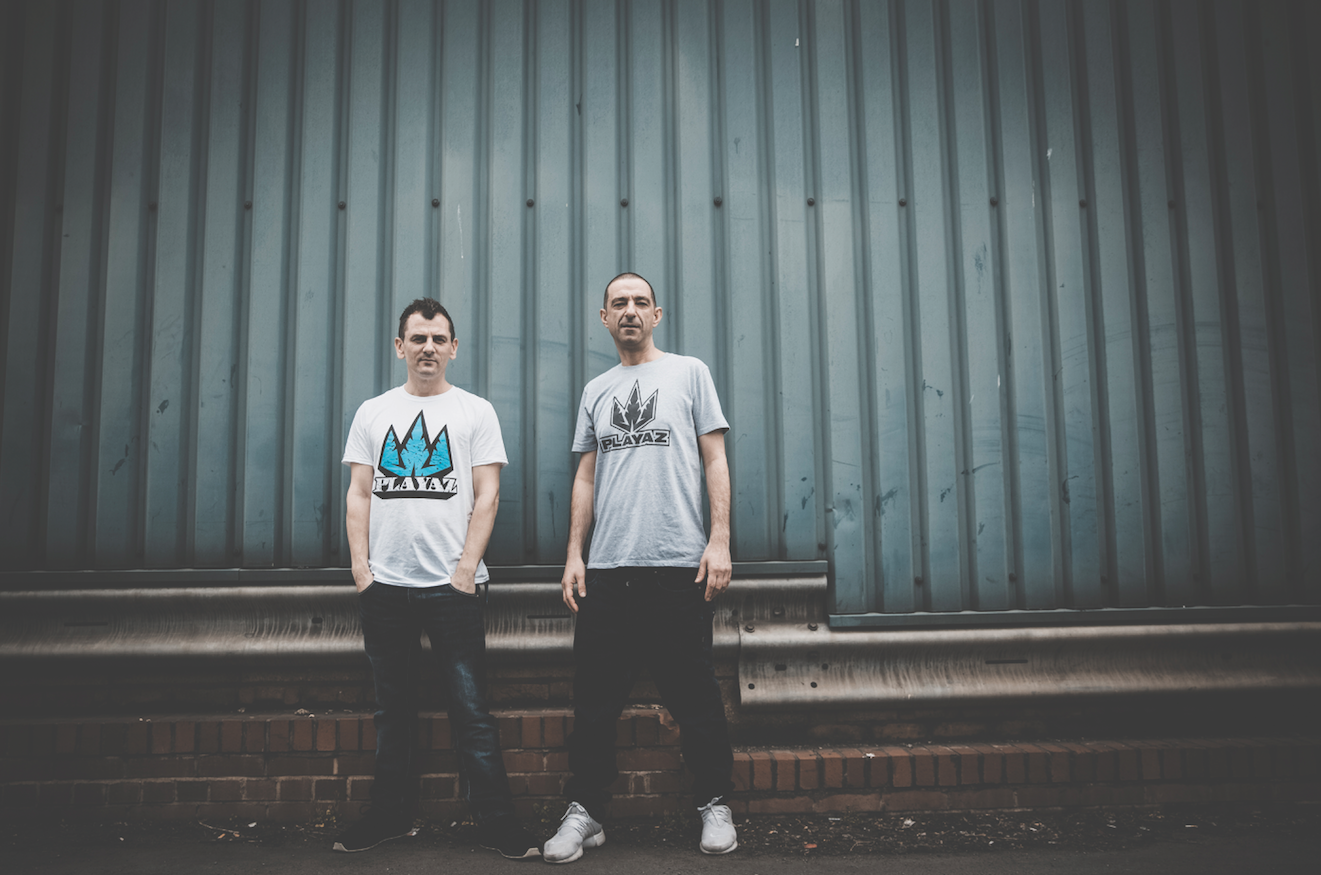
Hype & Hazard
This is why Hazard is cited as the don of the big bassline sound we’re talking about here. Call it dancefloor, call it jump-up, call it what you like: the hook-heavy sound Hazard (alongside other leading figures such as Hype, Majistrate, Macky Gee, Levela and, recently, the currently unavoidable Guv) has championed and crafted has been the major influence in the current jump-up movement.
“It is all about the hooks,” agrees Majistrate, an artist who’s been active in the heavier dancefloor side of drum & bass for over 20 years. “Kids now — even in Belgium where the leading sound has been pretty harsh and aggressive for years — are buying into the hooks. People want something to sing along to. It might be a vocal or the melody of the bass pattern. People don’t want to hear new tunes dropped in every 10 seconds. They want something a bit more than that.”
THE LOW DOWN...
Part of this new interest in big melodies, hooks and substance can be put down to typical cycles that all genres go through. Drum & bass has just come out the other end of two particularly prominent styles: in the mainstream there’s been the commercial pop goldrush, while on the underground the sound has been dominated by the technical neurofunk movement. One side saccharine and soulless, the other dense, complex and dangerously mannish and beardstroky — the thirst for riffy energetic underground drum & bass from fans and DJs alike is logical progression. Even within jump-up itself, the cycle has hit the same need.
“Jump-up does go through its own cycles, yeah,” agrees Logan D, head of one of the most consistent labels in this sound — Low Down Deep, a label that’s helped to break some of the genre’s exciting next generation talents such as Dominator and champions some of the scene’s unsung, long-standing contributors like Pleasure, Sly and Pacso. Son of original junglist Mickey Finn, if anyone’s followed jump-up’s cycles all their lives, it’s Logan.

Logan
“We’ve had a lot of crazy noisy stuff in recent years, which is what it is to be honest — kids go mental to it, so people make it and play it,” Logan continues. “But somewhere along the line the groove was lost. So now we’re hearing people looking for references and inspirations from the ‘90s and that’s created a groove that’s a lot more rolling and funky. It’s doing the whole jump-up scene justice and I can pin-point two key people responsible for it — Serum and Voltage. The sound they’ve been pushing for years is now feeding through. Finally!”
Some neuro exponents are looking for something heavier, rawer and more human (Teddy Killerz’ recent debacles into jump-up is a great example), while the jump-up scene has been incorporating warmer and funkier sounds. And they’ve arrived at the same place at the same time. Serum is definitely one of the most consistent and high-profile artists in this new merging of styles, but he’s not alone. Voltage, DJ Hybrid, T>I and Benny L are also just as guilty of murking jump-up with elements of jungle and rollers.
“People are now using the term roller to describe the funkier, less noisy sound that I make and I think that’s because they’ve got to draw a distinction between my kind of sound and the harder stuff,” agrees Serum, who, putting the whole jump-up discussion aside for a moment, has been enjoying some long-deserved focus and attention from across the entire drum & bass scene after years of consistent dispatches on labels such as Philly Blunt, Co-Lab, Dread and Low Down Deep.

Serum
NOISIER
The rise of big hooks and melodies and the merging of the original jungle sound and the harder, ‘noisier’ modern take on jump-up are only two flavours of a much deeper melting pot, however; we’re also experiencing an exciting fusion with the techier elements of drum & bass. Turno’s ‘Invaders’, for example, has been a huge track in recent times and has been supported across the board from Andy C to Ed Rush & Optical thanks to its universally heavy yet hard-to-classify sound. Annix are another good example; Nurtured by DJ Hype on Playaz for several years, their own unique experiments incorporate heavy aspects of tech (both in terms of the sound and their production levels) and has led to cross-scene support from acts such as Noisia.
“Annix and Noisia are a great example,” confirms Heist, another one of the movement’s longest-standing producers interviewed for this article. Almost 20 years deep into his career, Heist is best known for his heavier, riff-focused bassline tracks but has fingers in every sub-genre pie you can imagine; from soul-soothing rollers on Horizons to iced-out futuristic soundscapes on Metalheadz.
“It’s great to see guys like Noisia supporting artists who might be typically pigeonholed as jump-up,” Heist continues. “And it’s great to have guys in their position checking everything I send them. There’s no prejudice. That’s the way it should be and with DJs on the level of your Noisias and your Andy Cs, it’s spreading the best message for producers... Be that guy you can’t pigeonhole. Be that guy who understands the whole genre and supports as much of it as he likes in his DJ sets. Be that guy who makes tunes that every DJ wants to play.”
And DJs are playing them. Not just Andy C or Noisia. Not just wider, non-typical jump-up DJs such as High Contrast, Dimension or Marky (who, it has to be noted, has always celebrated jump-up in his vibe-optimised eclecticism). But even further again...
“My Nu Leng have been playing a tune of mine and Phantasy’s, which surprised me,” says one of jump-up’s most in-demand artists, Macky Gee, whose popularity is such that there was a queue to get into the Rough Tempo tent to see him play at Let It Roll festival last year. “Skrillex plays jump-up. Jauz is, too. And these guys are playing massive shows on a weekly basis. For them to support jump-up is turning a lot of heads.”
“I fucking live in Norwich mate and make tunes in my bedroom. I didn’t even know Skrillex knew my music!” laughs Upgrade. A young talent who fits Heist’s description as ‘that guy every DJ wants to play’, Upgrade’s sound ranges from sweet dubby swingers such as the currently scorching hot Bob Marley-sampling ‘Shot Down’ dubplate to heavyweight jump-and-awe tactics such as the raw and rolling ‘Blow’; one of two jump-up tracks Skrillex played in his recent Boiler Room set (the other was ‘Bricks Don’t Roll’). “The fact Skrillex supported ‘Blow’ is mad because when non-drum & bass DJs play our tunes, it’s usually the big anthems.”
The cross-pollination/outsider support doesn’t stop at big EDM DJs. The most important influence on the current surge of energy and momentum in jump-up is much closer to home. Both sonically and culturally, grime has helped bring jump-up — a scene characterised by the genre’s biggest MCs — to the fore.
“Musically it’s very similar; it’s hooky, it’s quite simple in its elements, it makes you move, and it’s raw,” says Turno, who’s known for switching up his sets with a grime section. “It’s also the first completely MC-led scene from the UK that’s blown up. Through grime, people have had more exposure to MC styles and lyrics so they get jump-up more. Ghetts even mentions Skibadee in one of his tunes.”
“A lot of the grime originators have their roots in jungle,” agrees Hype. “They’ve been showing their respect and love for people like Skibba and Shabba, who were their early heroes themselves. MCs have worked fucking hard to push what they do while pretty much being shut out by a lot of promoters and label nights and so on. I think it’s great for them that they’re finally getting the recognition they deserve.”

FUSION
With all this cross-scene fusion, support from notable selectors and external influences, jump-up is getting the recognition it deserves, too. Like MCs, in many ways the whole sub-genre has been shut out of the wider picture. Label nights have dominated the drum & bass UK nightscape, focusing strictly on their own sound. And, in the pursuit of commercial crossover success, many acts have been pushed towards bigger festival shows and kept off the more underground raves (which jump-up DJs still rule and pulls crowds of thousands). Even this has been beneficial; time away from the spotlight has helped creative incubation.
“Because the so-called superstar artist is removed from the underground, their own sound usually changes as their career moves in another direction, creating a void in the underground,” explains DJ Hype who, as one of the foundation DJs who helped develop and push jungle since before it was jungle, has weathered the underground/mainstream cycles more times than most. “That’s usually when you see the new young, ground level DJs/producers and even promoters coming forward to try their thing — they’re the next generation.
“Often, it’s not perfect at first, but it develops over time,” Hype continues, “and they bring a new angle to the drum and bass sound; then you probably get a two- to three-year period where they grow on the underground — their productions get better and the fanbase grows and grows, then one hit record pops up and becomes the year’s anthem, meaning it can no longer be ignored. Then... Hey presto, it’s the in-thing and everyone starts loving it.”
While jump-up isn’t short of massive underground anthems, for now it hasn’t had its big crossover hit. Not for the lack of trying; last year Island Records thought it would be wise to ask Hazard to add a vocal to ‘Bricks’. Even as one of the most popular and heavily played (and sung-along to) tunes this decade, it still didn’t have the commercial crossover appeal the major label may have hoped. There’s every chance jump-up may never crossover commercially; the founding principal of jump-up is that it’s meant only for dancefloors. There’s a reason DJ Guv’s ‘Warning’ hasn’t been in the background of Saturday Kitchen.
“We don’t make it for radio, or driving in your car or even the gym, unless that’s your thing. It is music to make you go ‘what the actual fuck?’ at a rave,” grins Upgrade. “It’s just something you can enjoy. I like silly music. I love that appeal. It’s an opportunity to be silly and to jump around like an idiot and not stand at the back scratching your beard at how a snare is made. And this is the thing; jump-up fucks all the theory and technical stuff out of the window. It doesn’t have to be melodic. It doesn’t have to make sense. It can be atonal or rough as fuck. As long as it sounds good in the rave, it’s working.”
It has to be noted that this dedication to the dancefloor and eager technical free-for-all does have its drawbacks. Echoing Hype’s statements about the production levels taking time to develop, all DJs interviewed for this article admit that jump-up suffers its fair share of sub-par sounds.

Mollie Collins
“Because we don’t have a physical dubplate culture anymore, and people don’t have to invest real money in actually getting music out, the bar is pretty low,” admits Heist, who plays a tight quality control game with his labels Sumo, Co-Lab and Calypso Muzak. “Sometimes it seems like everyone can come in. It’s different in genres like neuro, where you have to be pretty damned good to turn people’s heads. In jump-up, I’ve seen acts come along with complete samples of other man’s tunes and getting attention!”
“Yeah, there’s still a lot of rubbish jump-up,” agrees Mollie Collins, who has torpedoed to fame in the last two years as a DJ whose mixed-style signature mirrors the fusion jump-up is having itself. “But that’s our job, isn’t it? To pull out the good stuff and make sure that gets the support. I play what I think sounds good and will kick off on the dancefloor.”
KICKING OFF
And here’s the drop: the dancefloors really are kicking off. More than ever, according to Hazard. “It’s mad,” he says. “In all my years of DJing, I’ve never experienced parties like the ones I’m playing at now. They’re young, they’re seriously up for it and buzzing for what we play. There are a lot of kids who love drum & bass all over the UK.”
“It’s a lot like it used to be back in the early days,” Majistrate agrees. “You can go from Birmingham to Bristol to Manchester to Southampton, and everywhere you go it’s ram-packed. No party is having a knock-on effect on the other, they’re all massive.”
This is spreading internationally, too. Belgium isn’t the only source of air-miles for jump-up-related artists, almost every DJ in this article is keen to cite the exciting scenes in Austria, Czech Republic and beyond.

Majistrate
“Jump-up right now is being picked up in countries and places that it hasn't done before,” explains Levela. Cutting his teeth as resident at key rave Innovation in the 2000s, the Multifunction Records founder was one of the earlier jump-up artists to be supported by major US EDM acts and regularly represents the sound on the other side of the world. “I was on tour in Latin America last year and playing in places like Venezuela and Colombia where they very rarely see international jump-up DJs,” Lavela tells DJ Mag. “It became apparent that it was a very new sound to them and they were incredibly excited by it — which in turn excited me!”
Drum & bass fans have a lot to be excited about — full stop. For the first time in years it genuinely seems like promoters, DJs and other sub-genres within the scene are showing more unity and support for each other. It’s evident in the exciting sounds, it’s evident in most d&b DJ sets. But, tellingly, the strongest evidence is in this summer’s festival line-ups.
“I’ve lost count of how many names I’ve seen lined-up for Glastonbury,” says Turno, who was one of only three jump-up acts booked to play at Hospitality In The Park last year (the other two, Dominator and Logan D, were booked with him for a b2b2b session). “Boomtown, SW4, Let It Roll, Hospitality In The Park. There is definitely a lot more diversity on line-ups this year... And a lot more representation of drum & bass full stop. I’m talking about the whole movement.”
“It’s all just drum & bass at the end of the day, right?” says Majistrate, signing off. “The scene isn’t big enough to have stupid walls between the sub-genres anyway. It’s amazing to see we’re diversifying more and people are taking more aspects into their sets and playing on broader line-ups. This way we’re all in it together and all get to inspire each other. I think some of us forgot that for a while... Long may this unity continue.”
Amen.

Turno
NEXT-GEN BIG-UPS
Ten essential up-and-coming new dons bigged up by their peers
ANNIX
Levela: “My personal favourite producers to come through in recent years has to be Annix. They have created a hybrid crossover with all the feel-good, high energy vibes of jump-up but with a neurofunk swing — and in a technically incredible way! They make drum & bass strictly aimed at the dancefloor in their own unique way. Definitely worth checking out.”
BOU
Serum: “There’s a great scene bubbling up in Manchester at the moment, and one guy who’s really impressed me is Bou. He’s got that blend of having a modern sound but with that extra touch of character.”
EGO TRIPPIN
Logan D: “Ego Trippin have really found their sound lately. They’ve brought back the older style and revamped it in their own way. It takes me back to when I was a kid; warm, melodic but heavy as fuck!”
K MOTIONZ
Mollie: “He’s been around for a few years now but he makes some seriously good fucking jump-up! And he’s only 17! He’s so quick in the studio, just knows his shit incredibly well. Very inspiring and very sick!”
MATZET
Macky Gee: “Matzet is making some really amazing melodic musical stuff. He reckons he’s influenced by me but I think he’s got his own sound. He’s got a proper understanding of music production, and his basslines have their own unique vibe to them.”
NU ELEMENTZ
Majistrate: “This guy is smashing it. I’ve been watching him for time and his progression is really inspiring as he begins to mix things up more. He’s making those tunes that a lot of DJs want to play. He’s not just stuck in one style.”
OZ
Heist: “One of the most talented new producers I’ve met in years. He’s got everything from liquid to dark techy stuff. Noisia are playing his tunes, Goldie, Lenzman. He’s versatile. And deadly.”
SIMULA
Upgrade: “His sound is scatty! It’s raw. It’s not perfectly tuned or mixed but the way it comes together makes you pull the most fucked-up faces.”
TYKE
Hazard: “Tyke has been killing it for years now. He does things so differently. Cheese-free with big sways of vibe: You could class it as jump-up or dancefloor. Put it this way... When he sends me a four-track EP, I have to play all the tunes. I never do that with any other artist. He’s got that sound.”
